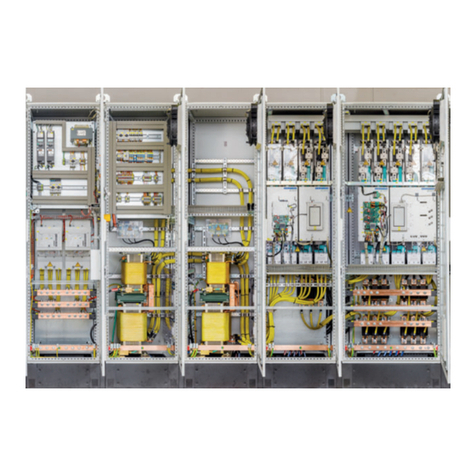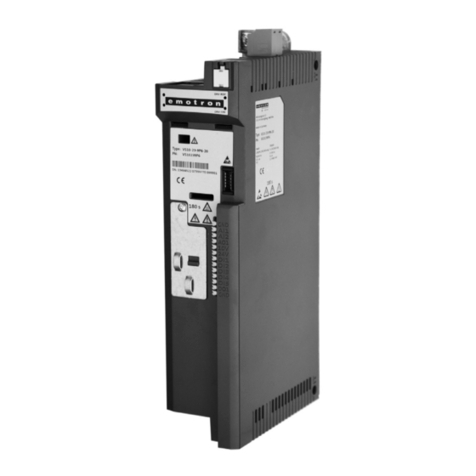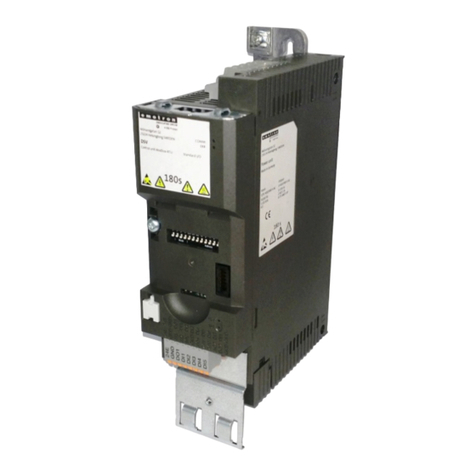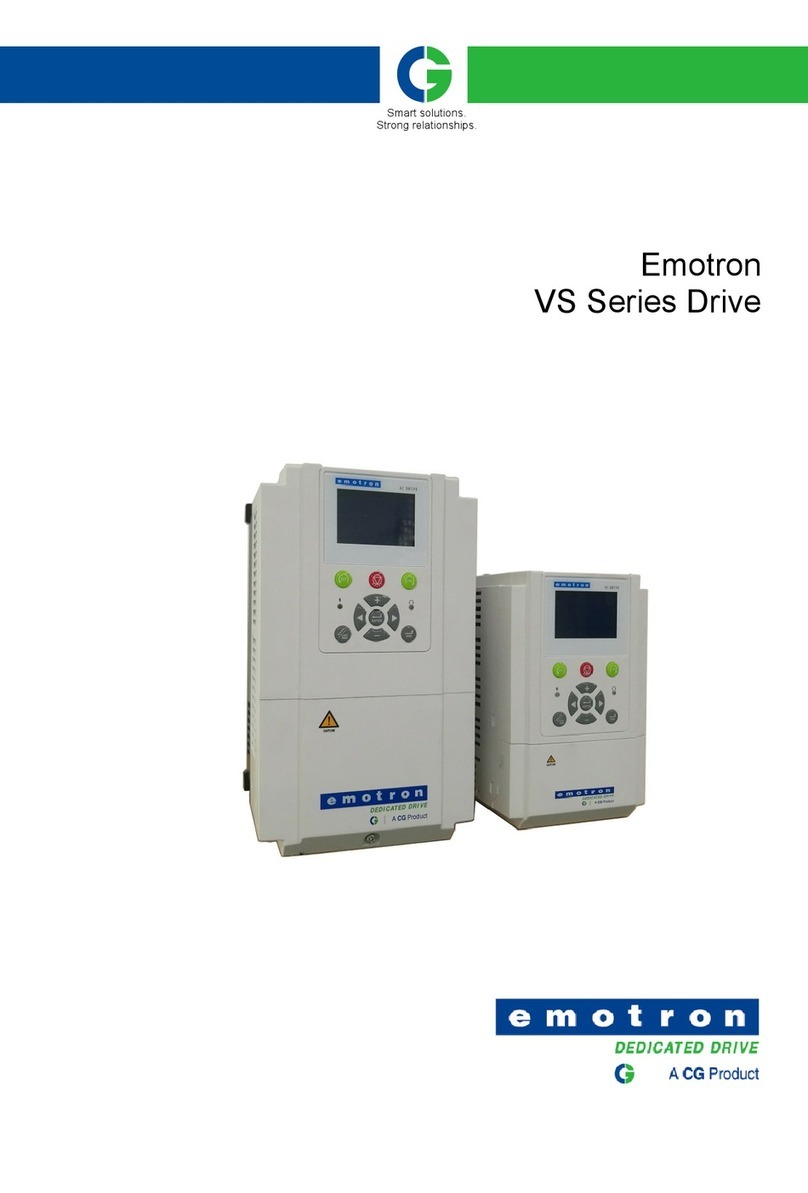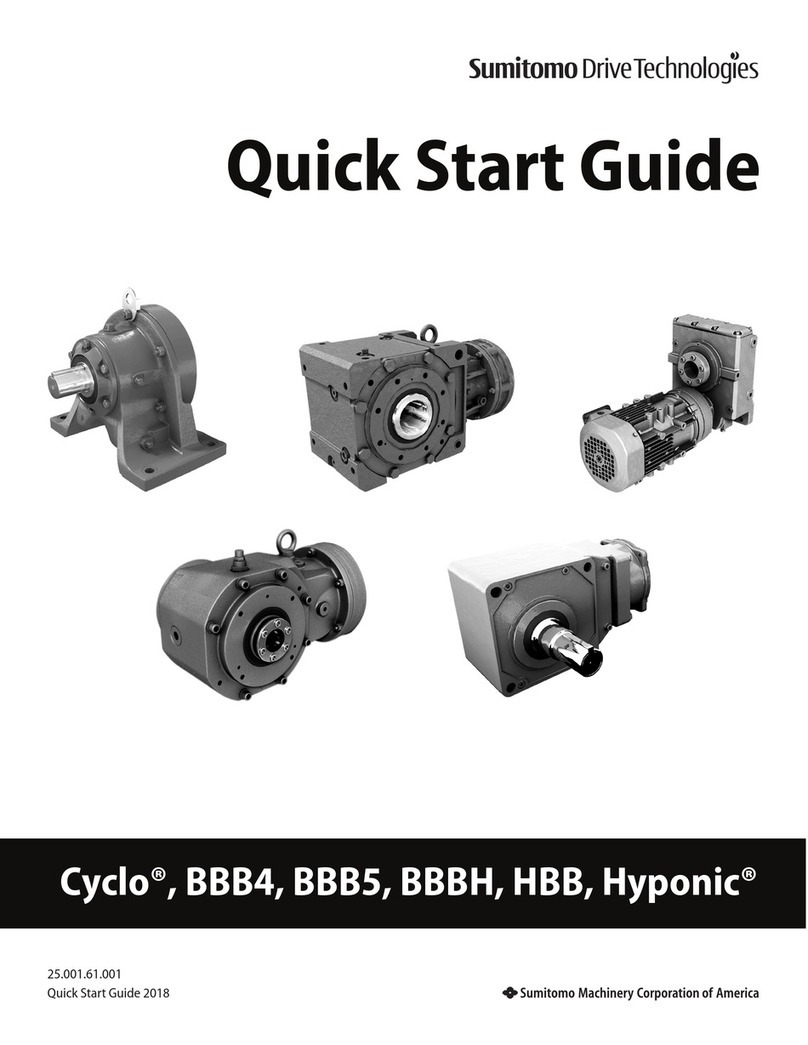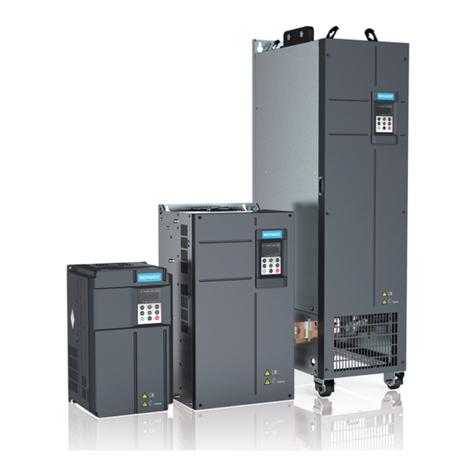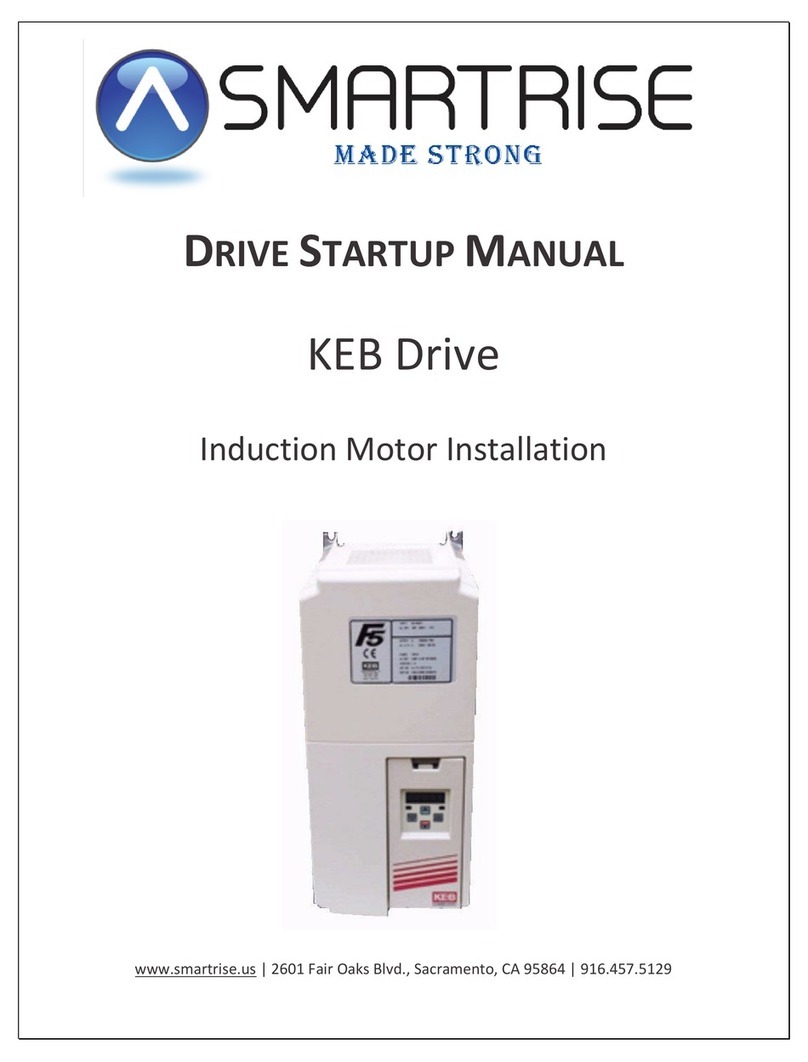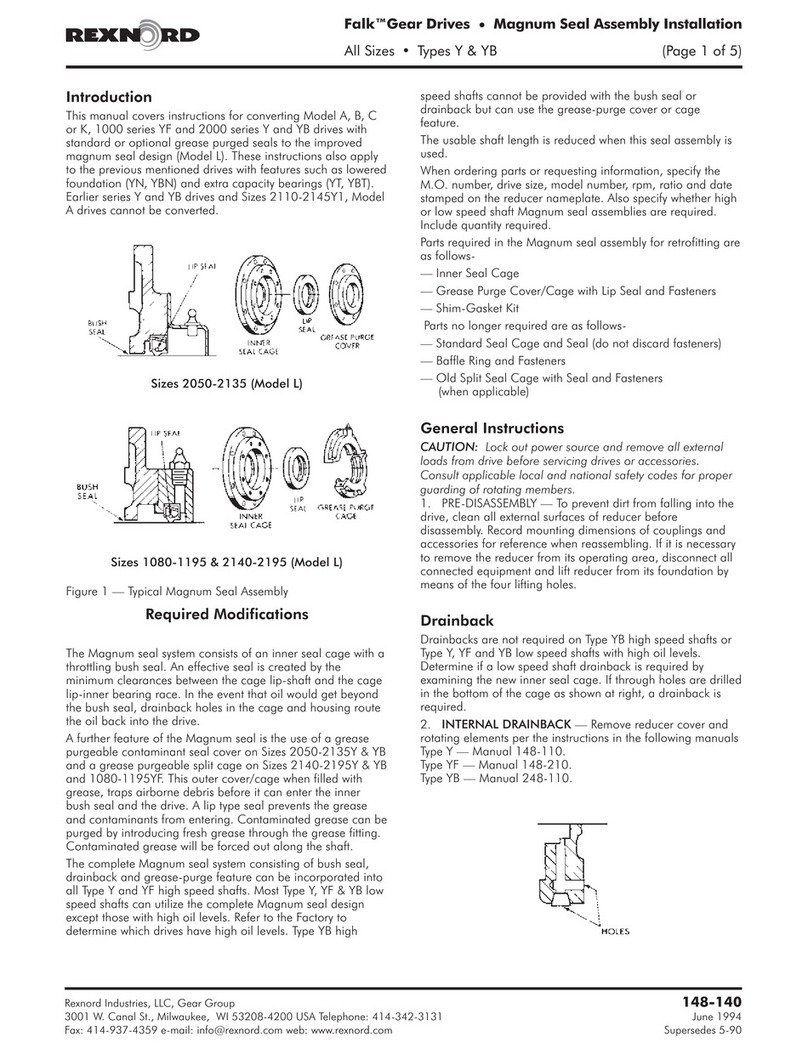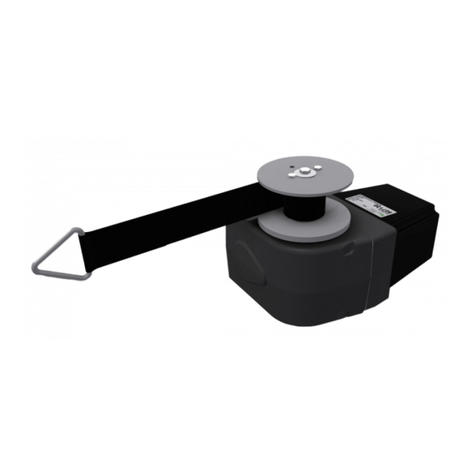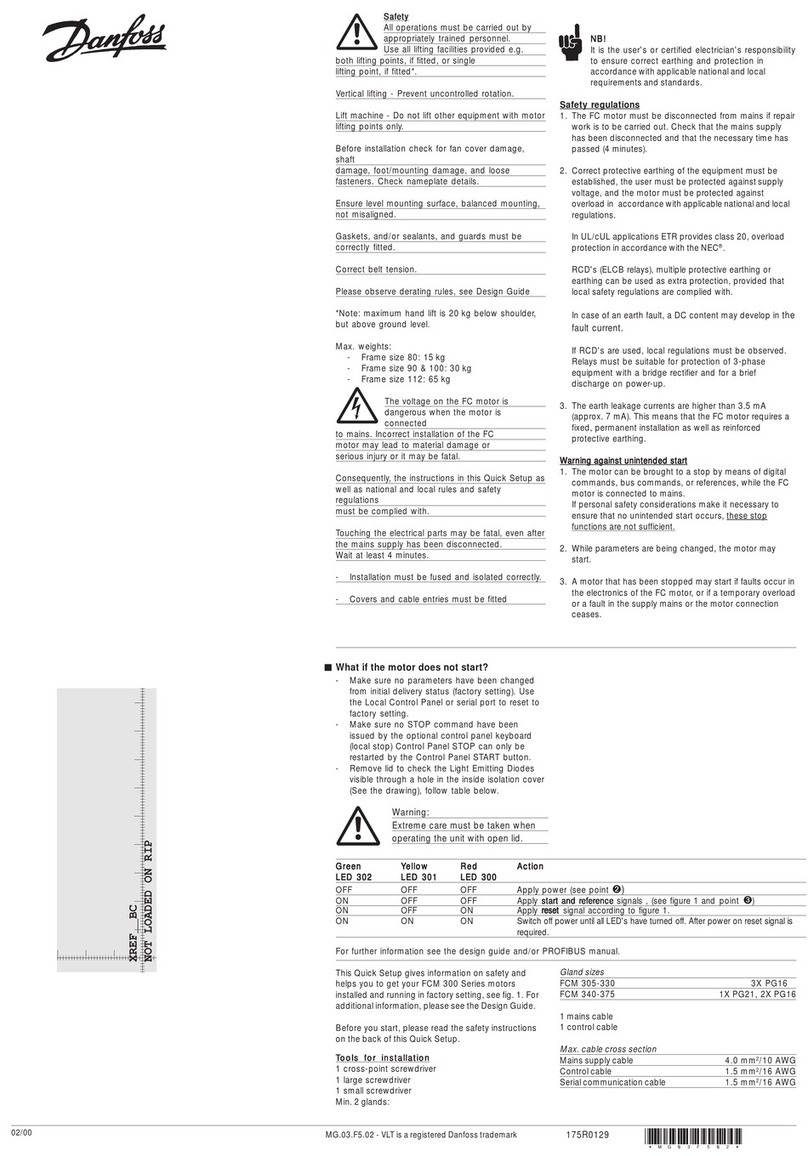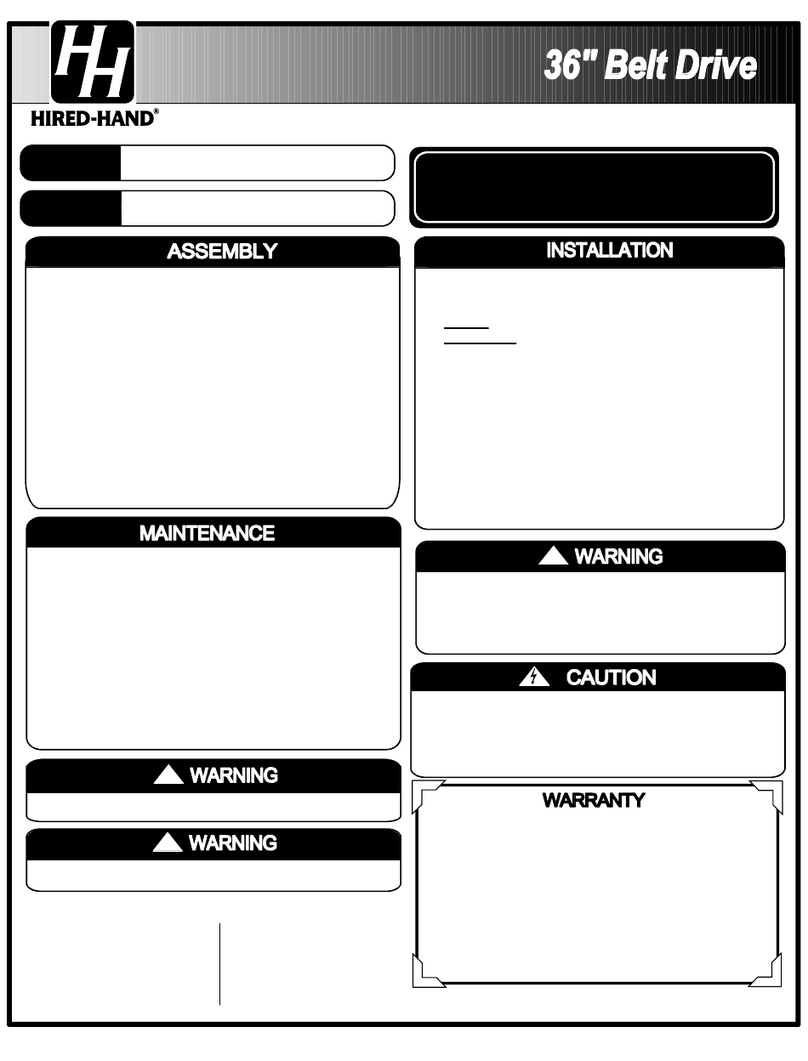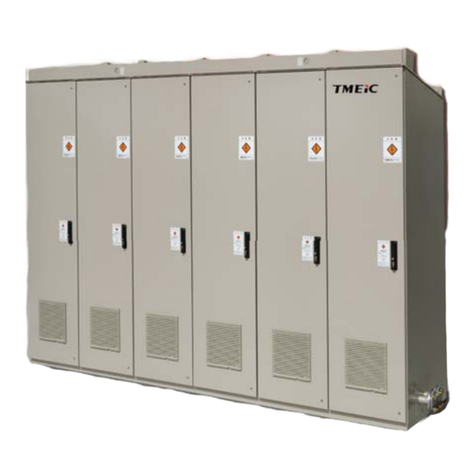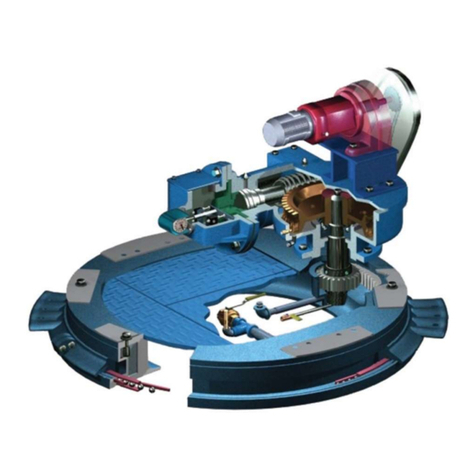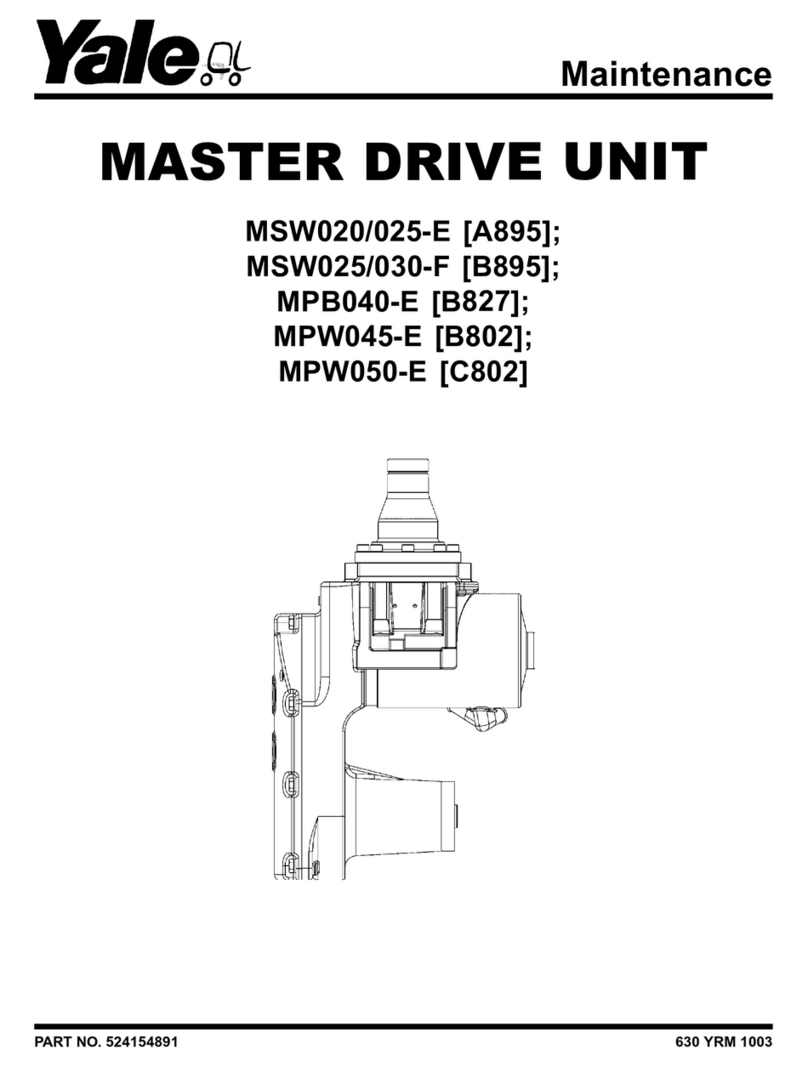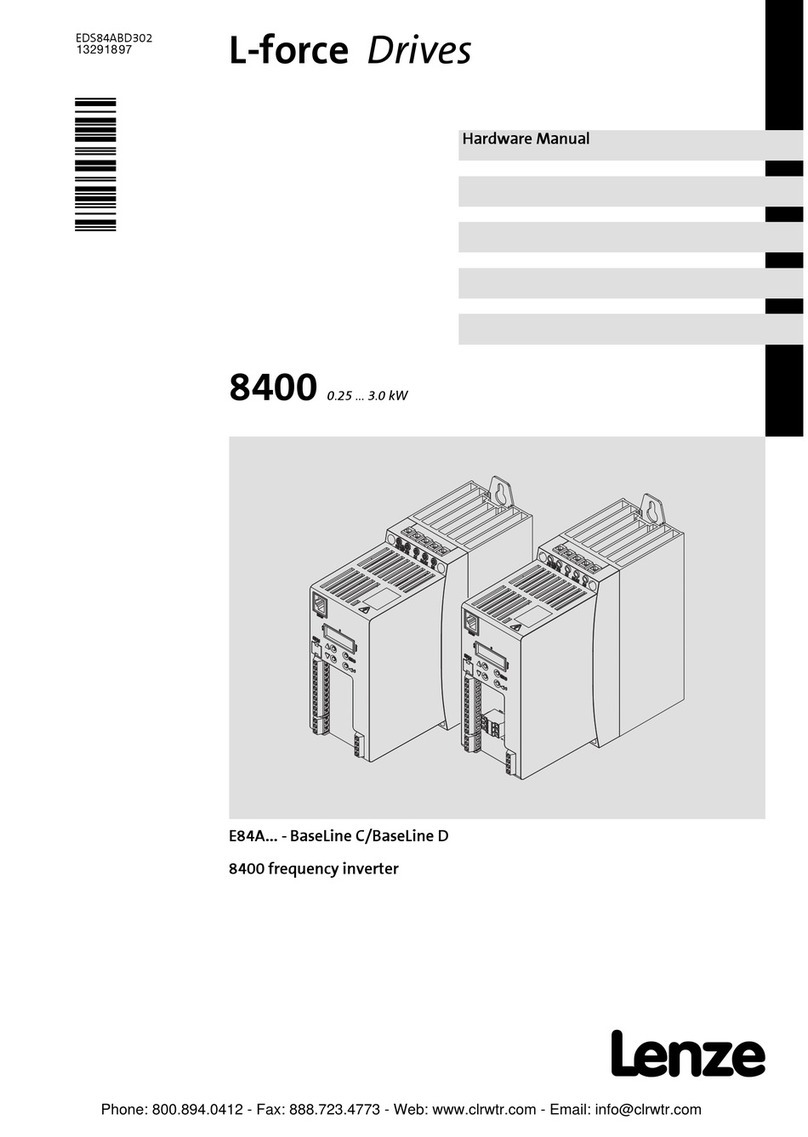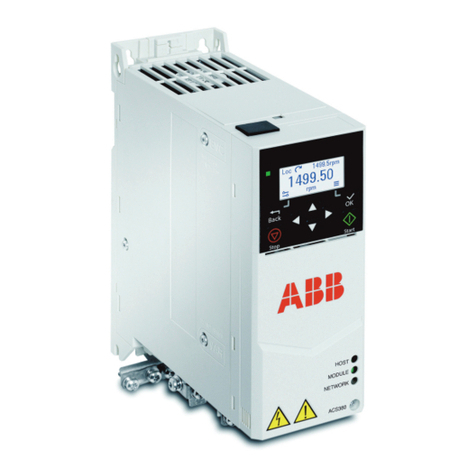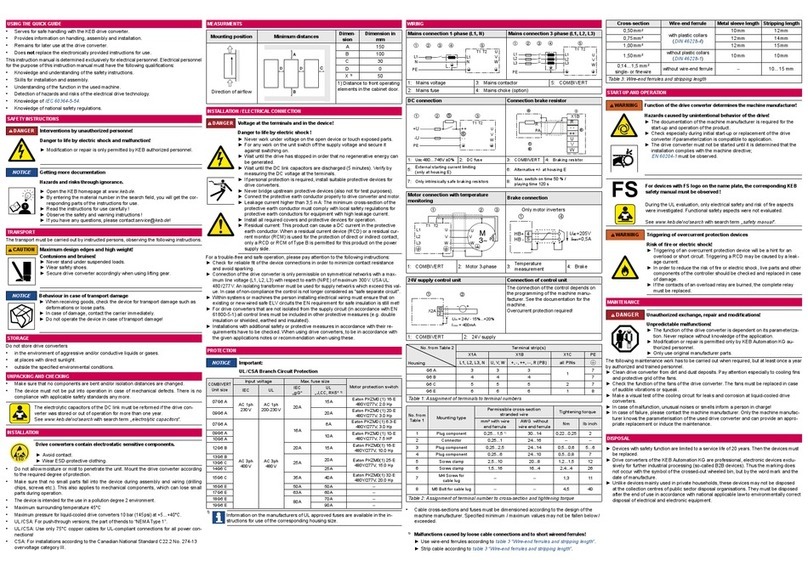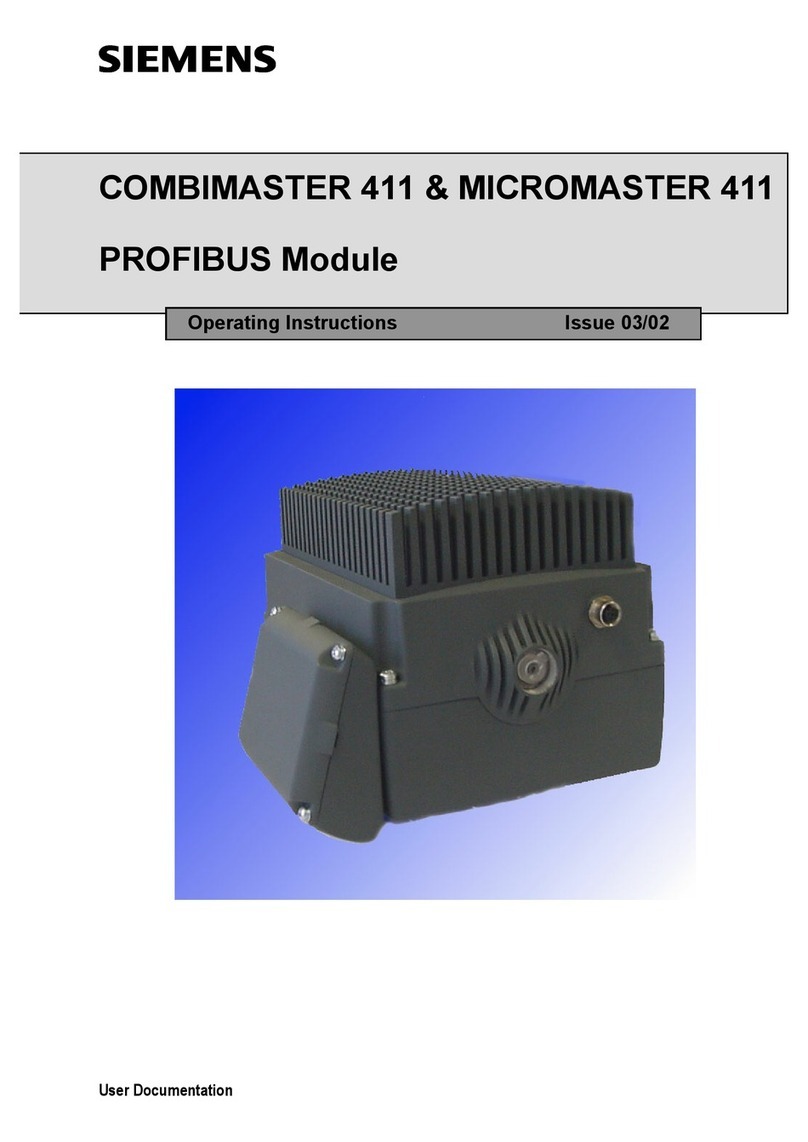CG Emotron VS30 Guide

Emotron VS30 AC drive
4 - 10 hp
Use in UL approved systems
Mounting and switch on instruction

2
This page intentionally left blank!

3
Contents
Contents
1General information 5
1.1 First read, then start 5
1.2 Notations and conventions 5
1.2.1 Product code 5
2Safety instructions 6
2.1 Basic safety measures 6
2.2 Residual hazards 7
2.3 Application as directed 7
3Product description 8
4Mounting 9
4.1 Important notes 9
4.2 Mechanical installation 10
4.3 Electrical installation 12
4.3.1 Connection plan 12
4.3.1.1 Fusing and terminal data 13
4.3.2 Connection to the IT system 14
4.3.3 CANopen connection 15
4.3.3.1 Connection plan 15
4.3.3.2 Terminal data 15
4.3.3.3 Basic network settings 15
4.3.4 Modbus connection 16
4.3.4.1 Connection plan 16
4.3.4.2 Terminal data 16
4.3.4.3 Basic network settings 16
5Commissioning 17
5.1 Important notes 17
5.2 Before initial switch-on 17
5.3 Initial switch-on / functional test 18
6Technical data 20
6.1 Standards and operating conditions 20
6.2 Rated data 22

4
This page is intentionally left blank.

5
1 General information
First read, then start
1General information
1.1 Read first, then start
Read this documentation thoroughly before carrying out the installation andcommissioning.
▶Please observe the safety instructions!
1.2 Notations and conventions
1.2.1 Product code Emotron, examples:
VS30-40-7P3-20-C
VS30-40-016-20-M
VS
30
40
7P3
20
C
Series
3-phase
400-480V
Rated current 7.3A (400V)
IP20
CANopen + STD I/O
VS
30
40
016
20
M
Series
3-phase
400-480V
Rated current 16A (400V)
IP20
MODBUS + STD I/O
Information
and tools with regard to the Emotron products can be found on the Internet:
http://www.emotron.com/file-archive
WARNING!

6
Safety instructions 2
Basic safety measures
2Safety instructions
2.1 Basic safety measures
Disregarding the following basic safety measures may lead to severe personal injury and damage to
material assets!
The product
• must only be used as directed.
• must never be commissioned if they display signs of damage.
• must never be technically modified.
• must never be commissioned if they are not fully mounted.
• must never be operated without required covers.
Connect/disconnect all pluggable terminals only in deenergised condition.
Only remove the product from
the installation in the deenergisedstate.
Insulation resistance tests between 24V control potential and PE: According to EN 61800−5−1, the
maximum test voltage must not exceed 110 VDC.
Observe all specifications of the corresponding documentation supplied. This is the precondition for safe
and trouble-free operation and for obtaining the product features specified.
The procedural notes and circuit details described in this document are only proposals. It is up to the user
to check whether they can be adapted to the particular applications. CG D&A does not take any
responsibility for the suitability of the procedures and circuit proposals described.
The product must only be used by qualified personnel. IEC 60364 or CENELEC HD 384 define the skillsof
these persons:
• They are familiar with installing, mounting, commissioning, and operating the product.
• They have the corresponding qualifications for their work.
• They know and can apply all regulations for the prevention of accidents, directives, and lawsapplicable
at the place of use.
Observe the specific notes in the other chapters!

7
2 Safety instructions
Residual hazards
2.2 Residual hazards
The user must take the residual hazards mentioned into consideration in the risk assessment for his/her
machine/system.
If the above is disregarded, this can lead to severe injuries to persons and damage to material assets!
Product
Observe the warning labels on the product!
I
Description
Electrostatic sensitive devices:
Before working on the inverter, the staff must ensure to be free of electrostatic charge!
Dangerous electrical voltage
Before working on the inverter, check whether all power connections are dead! After mains OFF,
power con- nections X100 and X105 carry a dangerous electrical voltage for the time specified on
High leakage current:
Carry out fixed installation and PE connection in compliance with EN 61800−5−1 or EN 60204−1 !
Hot surface:
Use personal protective equipment or wait until devices have cooleddown!
Motor
If there is a short circuit of two power transistors, a residual movement of up to 180°/number of pole pairs
can occur at the motor! (For 4-pole motor: residual movement max. 180°/2 =90°).
This residual movement must be taken into consideration by the user for his/her risk assessment.
2.3 Application as directed
• The product must only be operated under the operating conditions prescribed in this documentation.
• The product meets the protection requirements of 2014/35/EU: Low-Voltage Directive.
• The product is not a machine in terms of 2006/42/EC: Machinery Directive.
• Commissioning or starting the operation as directed of a machine with the product is not permitteduntil
it has
been ensured that the machine meets the regulations of the EC Directive 2006/42/EC: Machinery Directive;
observe EN 60204−1.
• Commissioning or starting the operation as directed is only allowed when there is compliance with the EMC
Directive 2014/30/EU.
• The harmonized standard EN 61800−5−1 is used for the inverters.
• The product is not a household appliance, but is only designed as component for commercial orprofessional use
in terms of EN 61000−3−2.
• In accordance with EN 61800−3, the product can be used in drive systems that have to comply with the categories
given in the technical data.
• In residential areas, the product may cause EMC interferences. The operator is responsible for taking
interference suppression measures.

8
Product description 3
3Product description
DIP switch
Baud rate and bus adress
(CANopen/Modbus)
PE connection
Mains connection X100
Relay output X9
Network X2xx
Option
Network status LEDs
Interface X16
Diagnostic module
Control terminals X3
Standard I/O
IT screw
Motor connection X105
Shield connection
Control connections
Memory moodule X20
Inverter status LEDs

9
Mounting
Important notes
4
4Mounting
4.1 Important notes
Dangerous electrical voltage
Possible consequence: death or severe injuries
▶All works on the inverter must only be carried out in the deenergised state.
▶After switching off the mains voltage, wait for at least 3 minutes before you start working.
DANGER!

10
4
Mounting
Mechanical installation
4.2 Mechanical installation
Dimensions 4 ... 7.5 hp
All Dimensions in inches

11
Mounting
Mechanical
installation
4
Dimensions 10 hp
All Dimensions in inches

12
4
Mounting
Electrical
installation
Connection
plan
4.3 Electrical installation
4.3.1 Connection plan
Fig. 1: Wiring example
S1 Start enable --- Dashed line = options

13
Mounting
Electrical
installation
4
4.3.1.1 Fusing and terminal data
Inverter
VS30407P3 VS30409P5
VS3040013
VS3040016
Cable installation in
compliance with
UL
Operation
without mains choke
Fuse
Characteristic
all acc. to UL 248/CC
all acc. to UL
248/J, T, R
Max. rated current
A
25
25
25
35
Circuit breaker
Characteristic
Max. rated current
A
25
25
25
35
Operation
with mains choke
Fuse
Characteristic
all acc. to UL 248/CC
all acc. to UL
248/J, T, R
Max. rated current
A
25
25
25
35
Circuit breaker
Characteristic
Max. rated current
A
25
35
Earth-leakage circuit
breaker
≥ 300 mA, type B
Mains connection
Connection
X100
Connection type
Screw terminal
Min. cable cross-section
AWG
16
Max. cable cross-section
AWG
10
6
Stripping length
inch
0.35
0.43
Tightening torque
lb-in
4.4
11
Required tool
0.6 x 3.5
0.8 x 4.0
Motor connection
Connection
X105
Connection type
Screw terminal
Min. cable cross-section
AWG
16
Max. cable cross-section
AWG
10
6
Stripping length
inch
0.35
0.43
Tightening torque
lb-in
4.4
11
Required tool
0.6 x 3.5
0.8 x 4.0
PE connection
Connection
PE
Connection type
PE screw
Min. cable cross-section
AWG
16
Max. cable cross-section
AWG
10
6
Stripping length
inch
0.39
0.43
Tightening torque
lb-in
11
30
Required tool
0.8 x 5.5
PZ2

14
4
Mounting
Electrical
installation
Connection to IT system
4.3.2 Connection to the IT system
Internal components have earth potential if the IT screws are not removed. Consequence: the
monitoring functions of the IT system respond.
▶Before connection to an IT system be absolutely sure to remove the IT screws.
NOTICE!
TX10
TX10

15
Mounting
CANopen
4
4.3.3 CANopen connection
4.3.3.1 Connection plan
Fig. 2: Wiring example: CANopen network
4.3.3.2 Terminal data
Terminal description
CANopen
Connection
X216
Connection type
Spring terminal
Min. cable cross-section
mm²
0,5
Max. cable cross-section
mm²
1,5
Stripping length
mm
10
Tightening torque
Nm
-
Required screwdriver
0.4 x 2.5
4.3.3.3 Basic network settings
Use the DIP switch to set the node address and baud rate and to activate the integrated bus terminating
resistor.
B
Baud rate
CAN node address
R
d
c
b
a
64
32
16
8
4
2
1
OFF
OFF
ON
OFF
ON
20 kbps
OF
OFF
OFF
OFF
OFF
OFF
OFF
inaktv
OFF
OFF
ON
ON
50 kbps
Value from parameter
ON
OFF
OFF
ON
OFF
125 kbps
Node address - example:
aktiv
OFF
OFF
OFF
ON
250 kbps
OF
OFF
ON
OFF
ON
ON
ON
OFF
OFF
OFF
OFF
Value from parameter (500
kbps)
Node address = 16 + 4 + 2 + 1 = 23
OFF
ON
OFF
OFF
1 Mbps
All other
combinations
Value from
parameter (500 kbps)
Printed in bold = Factory setting
The network must be terminated with a 120 Ω resistor at the physically
first
and last node.
Set the "R" switch to ON at these nodes.
CH
CL CG
CH
CH
CH
CL
CG
A1
A2
A3
An
120 120 120 120
R R R R
X216 X216 CL CG X216 CL CG X216
R
d
c
b
a
CAN Address
64
16
32
8
4
2
1
Baud
O
N

16
4
Mounting
Modbus
4.3.4 Modbus connection
4.3.4.1 Connection plan
Fig. 3: Wiring example: Modbus network
4.3.4.2 Terminal data
Terminal description
Modbus
Connection
X216
Connection type
Spring terminal
Min. cable cross-section
mm²
0,5
Max. cable cross-section
mm²
1,5
Stripping length
mm
10
Tightening torque
Nm
-
Required screwdriver
0.4 x 2.5
4.3.4.3 Basic network settings
Use the DIP switch to set the node address and baud rate and to activate the integrated bus terminating
resistor.
R c b a 128 64 32 16 8 4 2 1
Mode Address
Bus termina-
tion
Baud rate
Parity
Modbus node address
R
c
b
a
128
64
32
16
8
4
2
1
OFF
n.c.
OFF
OFF
OFF
OFF
OFF
OFF
OFF
OFF
OFF
OFF
Inactive
Automatic detection
Automatic
Value from parameter
ON
ON
ON
Node address - example:
Active
Value from parameter
Value from
parameter
OFF
OFF
OFF
ON
OFF
ON
ON
ON
Node address = 16 + 4 + 2 + 1 = 23
Node address > 247: value from parameter
Printed in bold = Factory setting
The network must be terminated with a 120 Ω resistor at the physically
first
and last node.
Set the "R" switch to ON at these nodes.
TA
TB COM
TA
TA
TA
TB
COM
A1
A2
A3
An
120 120 120 120
X216
X216
TB COM
X216
TB COM
X216
O
N

17
Commissioning
Important notes
5
5Commissioning
5.1 Important notes
Incorrect settings during commissioning may cause unexpected and dangerous motor and system
movements.
Possible consequence: death, severe injuries or damage to materialassets
▶Clear hazardous area.
▶Observe safety instructions and safetyclearances.
5.2 Before initial switch-on
Prevent injury to persons and damage to material assets. Check the following before switching on the
mains voltage:
• Is the wiring complete and correct?
• Are there no short circuits and earth faults?
• Is the motor circuit configuration (star/delta) adapted to the output voltage of the inverter?
• Is the motor connected in-phase (direction of rotation)?
• Does the "emergency stop" function of the entire plant operate correctly?
WARNING!

18
5 Commissioning
Initial switch-on / functional test
5.3 Initial switch-on / functional test
Target: achieve rotation of the motor connected to the inverter as quickly as possible.
Requirements:
• The connected motor matches the inverter in terms of power.
• The parameter settings comply with the delivery status (Emotron setting).
1. Preparation:
1. Wiring of power terminals. (Chapter 4.3 Electrical installation)
2. Wire digital inputs X3/DI1 (start enable), X3/DI3 (reversal of rotation direction), and X3/DI4 (preset
setpoint 20 Hz).
3. Do not connect terminal X3/AI1 (analog setpoint selection) or connect it to GND.
2. Switch on mains and check readiness for operation:
1. Switch on mains voltage.
2. Observe LED status displays "RDY" and "ERR" on the front of the inverter:
a) If the blue "RDY" LED is blinking and the red "ERR" LED is off, the inverter is ready for operation.
The controller is inhibited.
You can now start the drive.
b) If the red "ERR" LED is lit permanently, a fault is pending.
Eliminate the fault before you carry on with the functional test.
LED status displays
"RDY" LED (blue)
"ERR" LED (red)
Status/meaning
off
off
No supply voltage.
blinking (2 Hz)
off
Inverter inhibited.
lit every 1.5 s for a
short time
Inverter inhibited, no DC-bus voltage.
blinking fast (4 Hz)
Inverter inhibited, warning active.
on
Inverter inhibited, fault active.
on
off
Inverter enabled.
The drive rotates according tothe
setpoint
specified.
blinking fast (4 Hz)
Inverter enabled, warning active.
blinking (1 Hz)
Inverter enabled, quick stop as response to a faultactive.
Start/
Stop
20 Hz
X3
DI1
DI3
DI4
24V

19
Commissioning
Initial
switch-on /
functional
test
5
Carrying out the functional test
1. Start drive:
1. Enable inverter: X3/DI1 = HIGH.
2. Activate preset setpoint 1 (20 Hz) as speed setpoint: X3/DI4 = HIGH.
The drive rotates with 20 Hz.
3. Optional: activate the function for the reversal of rotation direction.
a) X3/DI3 = HIGH.
The drive rotates with 20 Hz in the opposite direction.
b) Deactivate the function for the reversal of rotation direction again: X3/DI3 = LOW.
Speed characteristic (example)
DI1
AI1 [V]
10
0
DI4
Inverter enabled
Speed setpoint selection via X3/AI1 active t (In
this example X3/AI1 is connected to GND)
t
Preset frequency setpoint 1 active
DI3 t
Invert rotation
t
fset [Hz]
50
20
0
-20
2. Stop drive:
5 s 5 s
Preset frequency setpoint 1 (20
Hz)
t
1. Deactivate preset setpoint 1 again: X3/DI4 = LOW.
2. Inhibit inverter again: X3/DI1 = LOW.
The functional test is completed.
The commissioning process of the drive solution is described in a separate commissioninginstruc-
tion which can be found on the Internet in our download area:
http://www.emotron.com/services-support/file-archive/

20
6
Technical data
Standards and operating conditions
6Technical data
6.1 Standards and operating conditions
Conformities
CE
2014/35/EU
Low-Voltage Directive
2014/30/EU
EMC Directive (reference: CE-typical drive system)
EAC
TR TC 004/2011
Eurasian conformity: Safety of low voltage equipment
TP TC 020/2011
Eurasian conformity: Electromagnetic compatibility of
technical means
RoHS 2
2011/65/EU
Restrictions for the use of specific hazardous materials
in electric and electronic devices
Approvals
UL
UL 61800-5-1
in preparation
CSA
CSA 22.2 No. 274
Energy efficiency
Class IE2
EN 50598-2
Type of protection
IP20
EN 60529
Type 1
NEMA 250
Protection against contact
Insulation resistance
Overvoltage category III
EN 61800-5-1
0 … 2000 m a.m.s.l.
Overvoltage category II
above 2000 m a.m.s.l.
Control circuit isolation
Safe mains isolation by double/
reinforced insulation
EN 61800-5-1
Protective measures against
Short circuit
Earth fault
Earth fault strength depends on the operatingstatus
Overvoltage
Motor stalling
Motorovertemperature
PTC or thermal contact, I²xt monitoring
Leakage current
> 3.5 mA AC, > 10 mA DC
EN 61800-5-1
Observe regulations and safety instructions!
Mains switching
3-time mains switching in 1 min
cyclic, without restrictions
Starting current
≤ 3 x rated mains current
Mains systems
TT
TN
IT
Apply the measures described for IT systems!
Operation on public supply systems
Implement measures to limit the radio
interference to beexpected:
The compliance with the requirements for the
machine/plant is the responsibility of the
manufacturer of the machine or plant!
< 0.5 kW: with mains choke
EN 61000-3-2
0.5 ... 1 kW: With active filter
> 1 kW at mains current ≤ 16 A:
without additional measures
Mains current > 16 A: with mains
choke or mains filter, with
dimensioning for rated power. Rsce ≥
120 is to be met.
EN 61000-3-12
RSCE: Short-circuit power ratio at the connection
point of the machine/plant to the public network.
This manual suits for next models
6
Table of contents
Other CG DC Drive manuals
